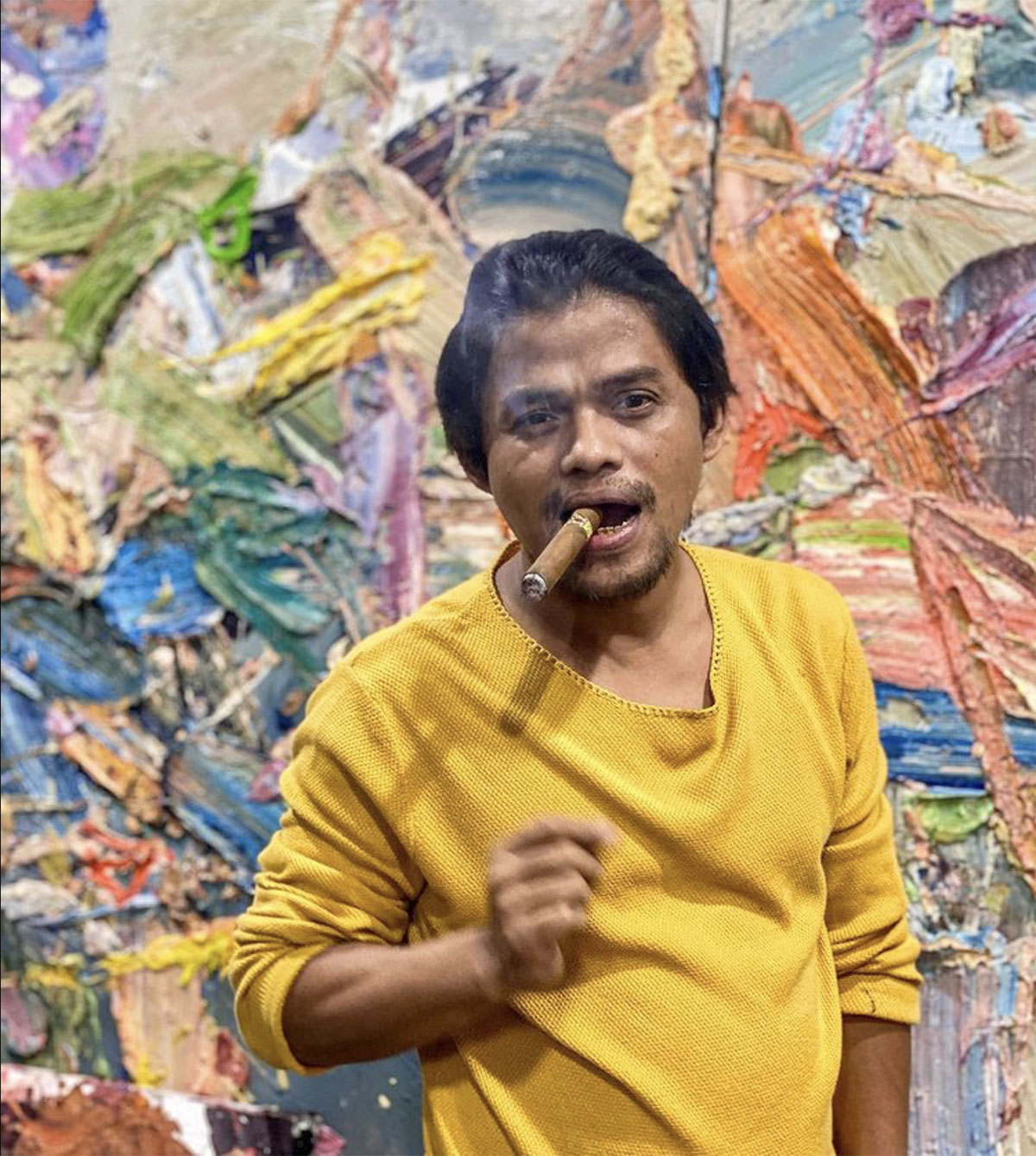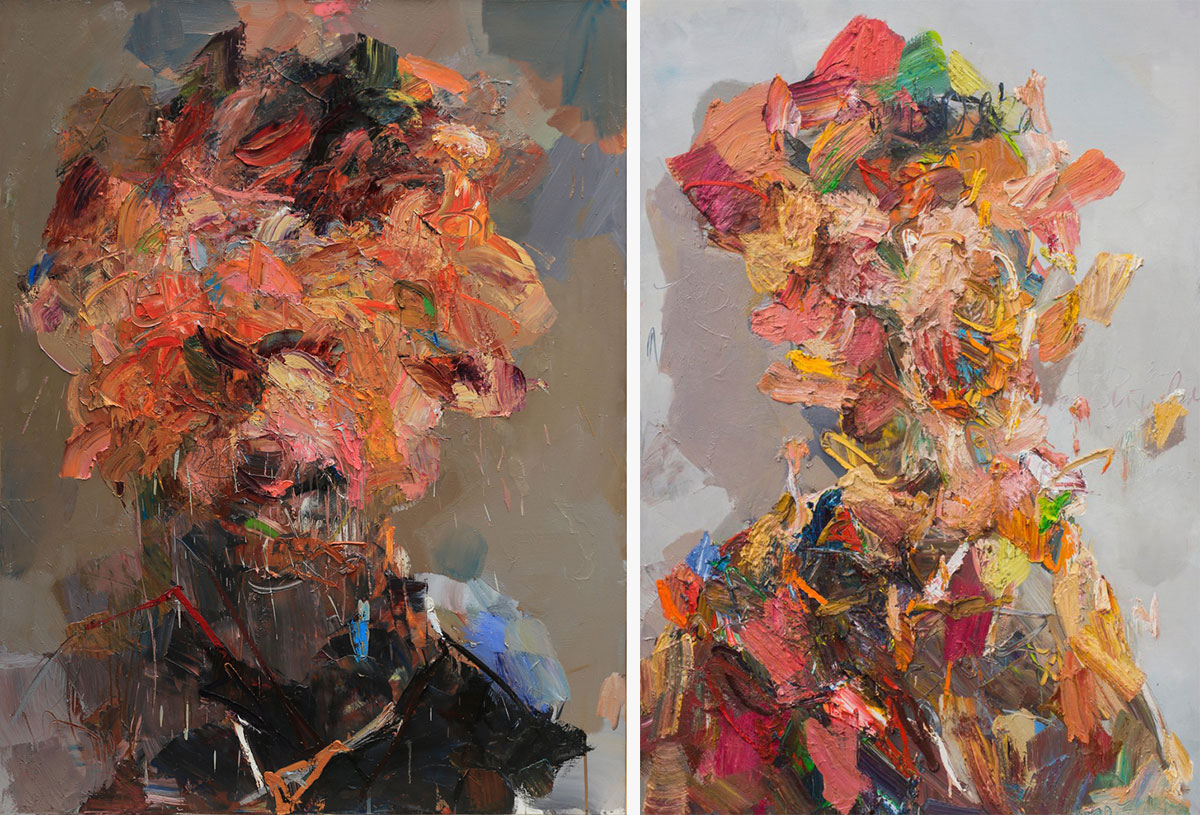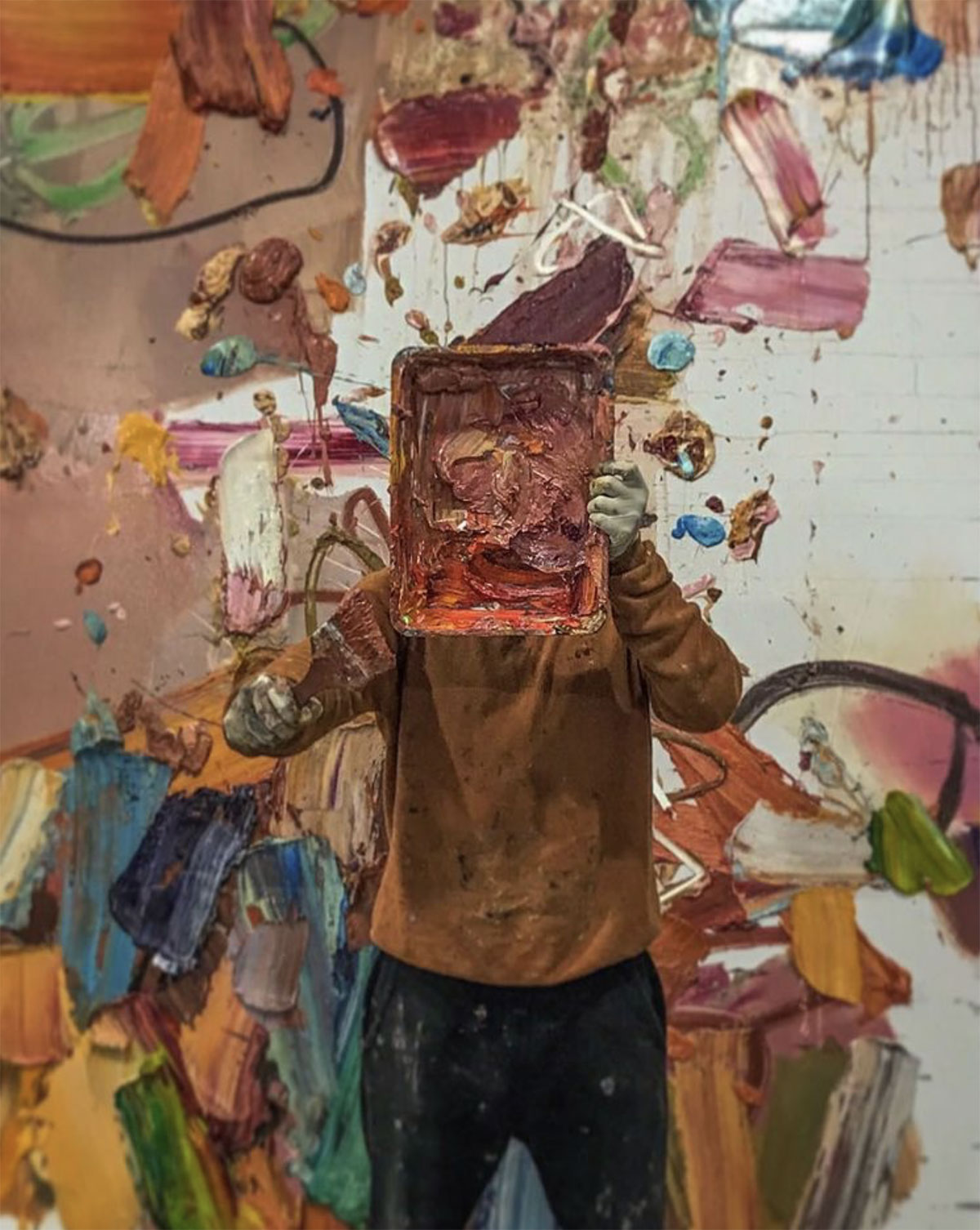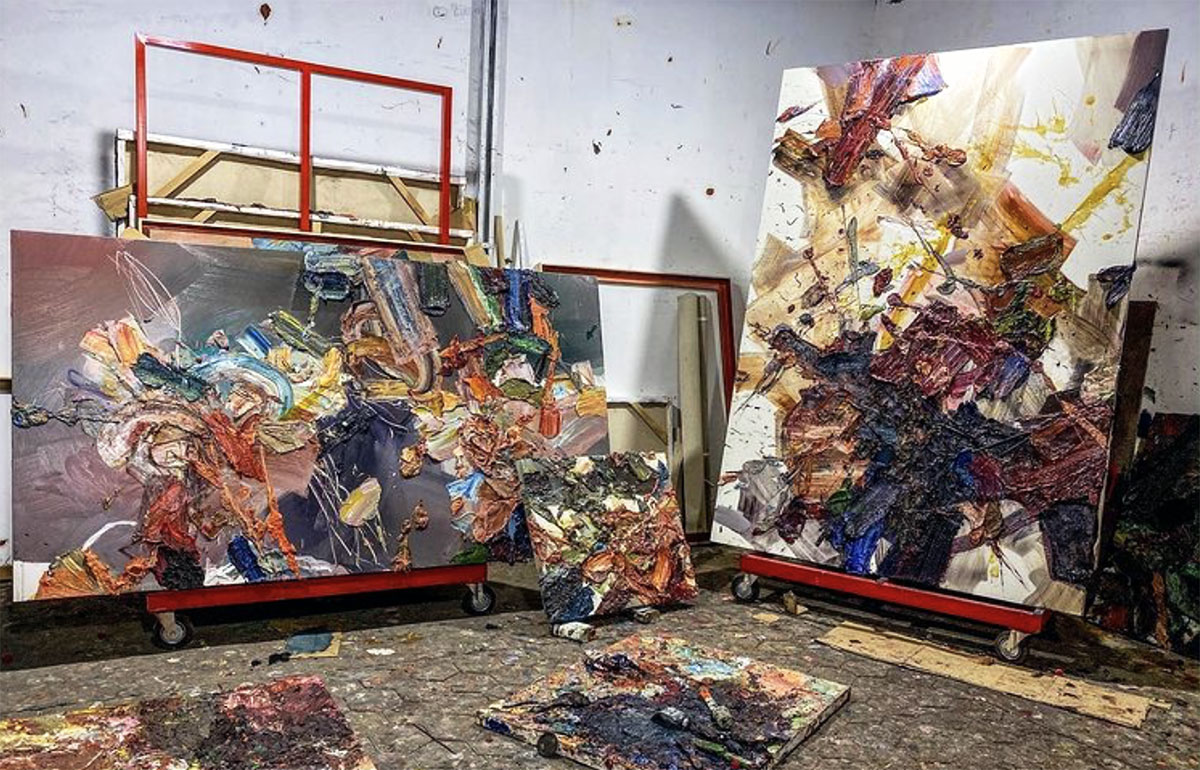PAINTER. YOGYAKARTA. INDONESIA.
My name is Erizal As. I am 42. I was born in Padang Panjang, but I currently live in Yogyakarta. I’m married with two children, and we have a pet fish! At the moment, I believe in the saying ‘Di Atas Langit Masih Ada Langit’ (the sky has no limit). This motivates me not to be complacent or satisfied with my achievements too soon, because there are still so many more wonderful things that the ‘sky’ has to offer. It reminds me to always keep looking up—to embrace the beauty of that vastness, of infinite possibilities.

I’ve loved drawing since I was a child, always doodling on my schoolbooks. In high school, I attended an art school called Sekolah Menengah Seni Rupa (SMSR), even though at the time, art was not a popular or conventional career path in Padang. My friends had never heard of my art school, but it didn’t matter to me. I knew it was my desire to learn art, and I pursued it without holding back. Then I moved to Yogyakarta and studied at the Indonesian Institute of Art to develop my artistic training. Fortunately, Yogyakarta is a vibrant artistic city that fosters the perfect atmosphere for artists to create and explore. I made friends who shared their experiences and engaged in lively discussions and debates on artistic ideas with me. This healthy competition in Yogyakarta’s art community was instrumental in helping me thrive and hone my skills and knowledge as an artist. I think it is very important for an artist to have this sense of community to support you, expand your perspective and help you understand the broader needs of the art world.
I feel my current painting practice cannot be separated from my entire artistic journey—it is the fruit of almost 25 years of acquiring knowledge, exposing myself to art, socialising with other artists, and endless hours of experimentations in my studio.
When I first started to stage solo exhibitions in the 2000s, you could detect recognisable figures in my paintings: fantastical animals in motion, human figures gracefully playing a musical instrument, for instance. But my instincts towards abstraction were already revealing themselves through my wild, gestural strokes and forms. My solo show in 2016, Refiguring Portraiture, exposed my deeper explorations into abstraction, in which I abstracted the faces of human figures completely—a metaphor for humanity’s eroding values and, consequently, the fragility of our truths and identities.
In 2019, I decided to eliminate the figure entirely and venture into pure, non- representational paintings, which I showcased in another solo exhibition Formless Existence. I am continuing to challenge humanity’s conflicted values and truths, expanding these concerns towards the deceptive nature of people in power—those who impose rules on the masses, but defy them simultaneously.
Yet, I am expressing such concerns through an abstract language, where bold, impasto strokes; dynamic textures and vibrant, contrasting colours serve as vital expressions of realities that are constantly in flux, and thus, formless. I also began allowing the paint to spill beyond the borders of my canvas. To me, it is an allegory for breaking boundaries within society, and commands a sense of liberation in my art.
However, I will admit that my current practice has so far been the most challenging period of my artistic career. I had to constantly wrestle with my ego to break free from the safety of figuration, and truly surrender into the abstract. Until today, this inner tension constantly fuels my practice.

I have always been fascinated with experimenting diverse painting forms—from portraiture to landscape, figurative to non-representational—and the complexities between them. This desire to explore has been the driving force in my creativity throughout my artistic career, and what moved me to eventually delve into the richness and endless possibilities of abstraction.
I do believe the strength in my work lies in how it constantly evolves. Yet these shifts occur through a steady, discerning process, usually emerging in cycles of around five years. While the finished paintings in exhibitions may appear spontaneous and different from my past work, they are in fact a culmination of years of playing and experimenting.
Currently, I would define my style as abstract expressionist. I had explored impressionist techniques in the past, but found it too delicate for my sensibilities. I was not engrossed in it. Abstract expressionism’s freeing, energetic strokes capture more the rawness of my ideas and emotions. However, even though I am now an abstract painter, I still feel one of the secrets to becoming a good painter is to master the basic shapes, anatomy and techniques of traditional painting. Developments and distortions emerge more powerfully after we master the fundamentals.
What people might not know about my process is that I am most comfortable working on around two to three canvases at the same time. When I am stuck or in doubt about one painting, I move on to another painting in the meantime. Later on, I return to that initial painting feeling revitalized, with fresh ideas in mind.
When I was starting out, I used to sketch before starting a painting. But when I moved to a studio practice, this process no longer worked for me. Now, I sketch directly on canvas with paint and brushes, but the sketches usually break apart and transform into new shapes, again and again.
I believe artists have their own unique habits and techniques. There are artists who are more structured, who prefer to plan and design sketches from the beginning, with the end result in mind. But there are artists who are not like that—they are more spontaneous and bring to the canvas whatever they feel at the present moment. I am more like the latter: I rarely fulfill planned sketches or colours, and I look instead for new possibilities and directions in the process of working on the canvas.
This way, the final result is always a surprise, a mystery. Though I prefer this method in painting, it also comes with its own anxieties. I am constantly struggling to figure out what it is I want to say. Sometimes, what comes out is something that was always inside of me, but I never acknowledged it before. Painting then becomes a way of accessing and getting more intimate with my subconscious.
My main motivation today is to become part of art history, to hopefully contribute something meaningful enough to be remembered years, even decades from now. I find that there are many artists who inspire me, but I am opposed to idolising or imitating any particular artist.
I would rather absorb their passion and energy, rather than copy their styles or ideas. That said, the sensation of painting is truly irreplaceable, making me feel connected to artists across generations dating back to the classical era. I think that feeling is what will always motivate me to get up every morning and paint.

Studios are like laboratories for artists. They are not like factories for printing products that have been designed. To me, the studio is more than that. It is the place where I am free to settle, think and process my ideas. I could come to the studio without any physical forms in mind, but once I am before a blank canvas, ideas immediately pour out, and are continually erased or transformed. It is where I feel comfortable to wrestle with my work: to stop and create something else whenever I want, and contemplate my creations later on.
My studio feels like a second home. I believe you can sense the soul of an artist through his studio, just as a person is reflected in his home. I would say my studio is quite messy, because I don’t feel comfortable creating in a very tidy environment. It is also filled with bright, vivid colours since that is the nature of my abstract work—packed with explosions of colour. Even as I am making new work, my surroundings are filled with old works from years back, works that are unfinished and even works that I believe are failures. It is therefore the place where I feel most vulnerable and exposed.
Having my works around also gives me the energy and stimulation to create. Oftentimes that is how my painting process begins: I see a work, and I become moved to make something.
Art to me is ‘splendor’. In the past, people would often refer to art as beautiful, but I feel the word ‘splendor’ has more power. In the visual arts, splendor can be found in lines, colours or even in the process of making the work itself. It is not just about being pretty or beautiful, but capturing this majestic, almost mystical feeling that would trigger a reaction of awe in audiences.
To me, art is all about the impact it has on those around you. And to get to that point of splendor and awe is no easy feat. In the past, I compared making art to climbing a peak that has no end. I still believe that is true.
